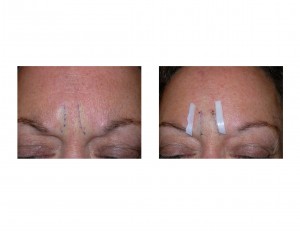Background: Frown lines are a major concern for many people as they make them look like they are scowling and angry. The frown lines are one of the major undesired facial features that have accounted for the meteoric rise in Botox sales and for making it a household name. Unknown to most, frown lines are actually the only FDA-approved cosmetic indication for Botox, even though it is widely off-label for other facial areas.
Despite the success of Botox in reducing the undesired actions on the skin between the eyebrows (aka glabella) of the corrugator and procerus muscles, one’s frown lines may not go completely away. Once the long-term actions of the muscles have permanently etched lines or grooves into the skin, muscle weakening along will reduce but not eliminate them. Botox is successful for the treatment of dynamic wrinkling (lines that appear when the face moves), static wrinkling (even when one is not moving muscles) requires a different or companion approach.

Adding some form of soft tissue filling is the next treatment strategy. Most commonly this is done with injectable fillers which are widely used. She did undergo Radiesse filler injections and was pleased with the results but wanted something that would last longer.
Other forms of soft tissue filling of facial lines and furrows are non-injectable and require a more invasive approach. (although not that much more invasive) Graft or filling options include one’s own fat, allograft dermal grafts (off-the-shelf) and a synthetic implant. (Advanta, also known as PTFE or Gore-Tex)


etching.
Case Highlights:
1) Deep glabellar furrows or wrinkles may be reduced by controlling the muscle action with Botox but will not be completely gone. In long-established frowning, the skin becomes permanently indented which is not responsive to reducing muscle action alone.
2) Soft tissue filling is a companion treatment to Botox for deep glabellar lines. Treatment options include temporary injectable fillers or longer-lasting implants.
3) While Botox and soft tissue fillers can be done at the same time, it is usually best to do Botox first and see what the results are. Management of the grooved skin can always be done later if further improvement is desired.
Dr. Barry Eppley
Indianapolis, Indiana


